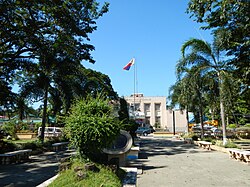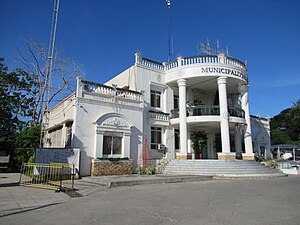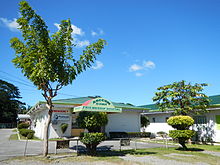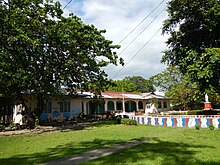| Apalit | |
|---|---|
| Municipality | |
| Municipality of Apalit | |
 Municipal Hall Municipal Hall | |
 Seal Seal | |
| Mottoes: Pampanga's Gateway to Manila The Blacksmith Capital of Pampanga | |
 Map of Pampanga with Apalit highlighted Map of Pampanga with Apalit highlighted | |
| OpenStreetMap | |
 | |
| Coordinates: 14°56′58″N 120°45′31″E / 14.949561°N 120.758692°E / 14.949561; 120.758692 | |
| Country | Philippines |
| Region | Central Luzon |
| Province | Pampanga |
| District | 4th district |
| Barangays | 12 (see Barangays) |
| Government | |
| • Type | Sangguniang Bayan |
| • Mayor | Oscar D. Tetangco Jr. |
| • Vice Mayor | Pedro C. Nucom |
| • Representative | Anna York P. Bondoc |
| • Municipal Council |
Members
|
| • Electorate | 62,083 voters (2022) |
| Area | |
| • Total | 61.47 km (23.73 sq mi) |
| Elevation | 7.0 m (23.0 ft) |
| Highest elevation | 35 m (115 ft) |
| Lowest elevation | −2 m (−7 ft) |
| Population | |
| • Total | 117,160 |
| • Density | 1,900/km (4,900/sq mi) |
| • Households | 27,391 |
| Economy | |
| • Income class | 1st municipal income class |
| • Poverty incidence | 9.54% (2021) |
| • Revenue | ₱ 452.7 million (2022) |
| • Assets | ₱ 536.8 million (2022) |
| • Expenditure | ₱ 390.2 million (2022) |
| • Liabilities | ₱ 181.6 million (2022) |
| Service provider | |
| • Electricity | Pampanga 3 Electric Cooperative (PELCO 2) |
| Time zone | UTC+8 (PST) |
| ZIP code | 2016 |
| PSGC | 035402000 |
| IDD : area code | +63 (0)45 |
| Native languages | Kapampangan Tagalog |
Apalit, officially the Municipality of Apalit (Kapampangan: Balen ning Apalit; Tagalog: Bayan ng Apalit), is a municipality in the province of Pampanga, Philippines. According to the 2020 census, it has a population of 117,160 people.
The town is famous for its Apung Iru Fluvial Procession, which is listed as one of the most significant water-based intangible cultural heritage of the Philippines where the festival happens every June 28th–30th; and for its blacksmithing.
Etymology
The town got its name after a big sturdy tree with the scientific name Pterocarpus indicus also known as Narra, known by Kapampangan as Apalit.
History
Apalit received official recognition as a separate town in 1582, while Gonzalo Ronquillo de Penalosa was the country's governor-general at the time. Apalit's town was mostly made up of four encomiendas: Apali (Pale), La Castilla, Cabambangan, and Capalangan. San Juan Nepomuceno was the new name given to the enconmienda "La Castilla" once it had been transformed into a town proper (Poblacion).
After severing ties with the Parish of Calumpit, The Apalit Parish of Saint Peter was established in 1597.
Capitan del Pueblo Don Pedro Armayan-Espiritu y Macam created the customary fluvial parade of Saint Peter on June 28, 1844, commonly known as "Libad ng Apung Iru," which is still observed today in Apalit during its town festival.
It is thought that the son of a specific Gatbonton named Pangpalung, who was once known as Macapagal, built Barrio Capalangan, which takes its name from the Kapampangan word "Palang" meaning machete or bolo, which the barangay takes pride of.
This Barrio was the home of Panday Pira, the first well-known Filipino maker of cannons, and got its name from the Kapampangan word "Palang," which means Bolo or Machete. It is said to have been founded by the son of a particular Gatbonton named Pangpalung, who in his youth also went by the name "Macapagal." After the Spanish conquest of Manila, he worked under Adelantado and Governor General Miguel Lopez de Legaspi, producing "Lantakas" cannons for Rajah Soliman's army.
During the reign of Capitan del Pueblo Don Joaquin Arnedo de la Cruz y Tanjutco and his heiress wife, Dona Maria de la Paz Sioco y Carlos, viuda de Tanjutco, Puerto Sulipan was once regarded as a haven for big businesses, politics, and "high society" in the Philippines from the 1850s until the 1910s.
Geography
Apalit is surrounded by Macabebe, Masantol, Minalin and San Simon in Pampanga, and Calumpit, Pulilan, and Baliuag in Bulacan.
It is 55 kilometres (34 mi) from Manila, 11 kilometres (6.8 mi) from the provincial capital, San Fernando, and 28 kilometres (17 mi) from Angeles.
Barangays
Apalit is politically subdivided into 12 barangays. Each barangay consists of puroks and some have sitios.
- Balucuc (Nuestra Señora de la Divina Pastora)
- Calantipe (Santo Niño)
- Cansinala (Nuestra Señora del Rosario)
- Capalangan (Holy Cross)
- Colgante (Holy Family)
- Paligui (Chair of St. Peter / Apung Iru)
- Sampaloc (San Roque)
- San Juan (San Juan Nepomuceno) (Poblacion)
- San Vicente (San Vicente Ferrer) (Business District)
- Sucad (Santa Lucia)
- Sulipan (Christ the Eternal High Priest)
- Tabuyuc (Santo Rosario)
Climate
| Climate data for Apalit, Pampanga | |||||||||||||
|---|---|---|---|---|---|---|---|---|---|---|---|---|---|
| Month | Jan | Feb | Mar | Apr | May | Jun | Jul | Aug | Sep | Oct | Nov | Dec | Year |
| Mean daily maximum °C (°F) | 28 (82) |
29 (84) |
31 (88) |
33 (91) |
32 (90) |
31 (88) |
30 (86) |
29 (84) |
29 (84) |
30 (86) |
30 (86) |
28 (82) |
30 (86) |
| Mean daily minimum °C (°F) | 20 (68) |
20 (68) |
21 (70) |
23 (73) |
24 (75) |
24 (75) |
24 (75) |
24 (75) |
24 (75) |
23 (73) |
22 (72) |
21 (70) |
23 (72) |
| Average precipitation mm (inches) | 6 (0.2) |
4 (0.2) |
6 (0.2) |
17 (0.7) |
82 (3.2) |
122 (4.8) |
151 (5.9) |
123 (4.8) |
124 (4.9) |
99 (3.9) |
37 (1.5) |
21 (0.8) |
792 (31.1) |
| Average rainy days | 3.3 | 2.5 | 3.6 | 6.6 | 17.7 | 22.2 | 25.2 | 23.7 | 23.2 | 17.9 | 9.2 | 5.2 | 160.3 |
| Source: Meteoblue (Use with caution: this is modeled/calculated data, not measured locally.) | |||||||||||||
Demographics
| Year | Pop. | ±% p.a. |
|---|---|---|
| 1903 | 12,206 | — |
| 1918 | 11,880 | −0.18% |
| 1939 | 14,330 | +0.90% |
| 1948 | 14,576 | +0.19% |
| 1960 | 25,408 | +4.74% |
| 1970 | 36,138 | +3.58% |
| 1975 | 41,283 | +2.71% |
| 1980 | 48,253 | +3.17% |
| 1990 | 62,373 | +2.60% |
| 1995 | 65,720 | +0.98% |
| 2000 | 78,295 | +3.82% |
| 2007 | 97,296 | +3.04% |
| 2010 | 101,537 | +1.56% |
| 2015 | 107,965 | +1.18% |
| 2020 | 117,160 | +1.62% |
| Source: Philippine Statistics Authority | ||
In the 2020 census, the population of Apalit, was 117,160 people, with a density of 1,900 inhabitants per square kilometre or 4,900 inhabitants per square mile.
Religion
Most inhabitants of Apalit are Christian, with a majority professing Catholicism, due to Spanish colonialism and imperialism from the 15th to 19th centuries. Other prominent Christian groups include Members Church of God International, Iglesia ni Cristo, and Muslims.
Catholicism


Apalit was first established as one of the visitas (mission chapel) under the administration of Convento de Calumpit. In 1597, the Augustinian chapter accepted Apalit as House of Order under the advocacy of San Pedro Apostol where Fray Pedro de Vergara OSA as its first parish priest In conjunction with the annual town fiesta, the Libad was established by the Capitan del Pueblo, Don Pedro Armayan-Espíritu y Macam, on June 28, 1844.Libad fluvial procession also reaching Calumpit even today to signify the old relationship of Apalit to its mother town Calumpit where San Juan Bautista is the patron of the Town.
The first church and convento was constructed under the tenure of Fray Juan Cabello as parish priest from 1641 to 1645. Fray Simón de Alarcia built another church made of concrete and tile in 1854–1860, but it was destroyed by a strong earthquake in 1863. The present neo-classical church was built under Fray Antonio Redondo, who was assigned to Apalit from 1873 to 1886.
Father Gallende wrote in La Iglesia de Apalit:
"Father Antonio Redondo, parish priest of Apalit from 1873 to 1886 laid the foundations of a new one in January 1876, following the plans of Don Ramón Hermosa, assistant officer to the minister of public works. The foreman was a certain Mariano Santos, a native of Guagua. After seven years of work, the church was finally completed in 1883. It was "the pride of Pampanga, an indelible tribute to Fr. Redondo and the people of Apalit.'"
It was officially inaugurated with solemn ceremonies held successively during the town fiesta from 28 to 30 June of the same year. The chronicler remarks that when there was no more sand or bricks, Fr. Redondo would ask the fiscal (sacristan) to go around town pealing the bells. Preceded by the town bands, he would lead the way towards the riverside with an azafate (a basket or hamper) on his head. Unquestioning, the whole town would follow him, and in less than two hours, the masons would have enough sand for two months. "The whole town of Apalit helped either with monetary donations, personal service, or with their good wishes." The church measures 59 meters long and 14 meters wide. The painting was done by a native of Apalit, an industrious pupil of Alberoni. The church possesses the qualities of good construction: "solidity, capacity, light and artistic beauty."
The towers were completed under the guidance of Rev Toríbio Fanjul in 1896. In 1989, a major church renovation was initiated by Monsignor Rústico G. Cuevas.
Feast of Saint Peter
The Libad, a fluvial procession in honour of the town's patron saint Peter the Apostle (known locally Apung Iru), is annually from 28 to 30 June. The event, where a centuries-old ivory image of the apostle is paraded along the Pampanga River, is one of the more famous religious processions in Pampanga.
History of the Image of Apung Iru

The life-sized, seated image of "Apung Iru" is an heirloom of the Armayan-Espíritu y Macam clan of Sitio Alauli, San Vicente, Apalit. The image, with its ivory face and hands, dates from the last quarter of the 1700s. Family tradition has it that Don Pedro Armayan-Espíritu y Macam (d. 1904)–or his parents Don Calixto Armayan-Espíritu and Doña María Macam, acquired the image from an aunt, Doña Máxima Santos–in exchange for a considerable parcel of agricultural land in Apalit. During the Spanish colonial era, Spanish friars shrewdly assigned the ownership of the town's patron saint to wealthy families, so that the former could be spared the expenses of its upkeep and annual fiesta. The first Libad was held in 1844.
Custody of the image of Apung Iru has passed to the direct descendants of Don Pedro Armayan-Espíritu y Macam, who married three times: first to Doña Dorotea Arnedo; then Máxima Santa Rita; and finally Ysabel Dungo y Nocom. Don Pedro originally bequeathed the image to his favourite, his youngest daughter Doña Ysidora "Orang" Espíritu y Dungo (later Mrs. Jesús Justo González), but she did not want the responsibility of being the image's camarera (custodian). She passed it on to her elder, spinster sister Doña Aurea "Ondeng" Espíritu y Dungo. After Doña Aurea's early death, Don Pedro's eldest daughter Doña María "Maruja" Espíritu y Dungo (later Mrs. Macario Arnedo) became the image's camarera. In 1928, Doña María translated the image of Apung Iru from the Armayan-Espíritu ancestral home in Sitio Alauli in Barangay San Vicente to her house in Barrio Capalangan, where it has remained since.
Doña María died in 1934, and her second daughter Doña Ysabel "Tabing" Arnedo y Espíritu (later Mrs .Fernando Dueñas Reyes) became the image's "camarera" until her own death in 1970. Doña María's third daughter, Doña Rosario Lucia "Charing" Arnedo y Espíritu (later Mrs. Augusto Diosdado Sioco González) became camarera until her death in May 1977. The youngest daughter, Doña Elisa Juana "Ising" Arnedo y Espíritu (later Mrs Fortunato Kabiling Sazon) became the next camarera until her death in May 1987. Doña Elisa's eldest daughter, Dr. Erlinda Crispina "Linda" Arnedo Sazon (later Mrs. Enrique Espíritu Badenhop) succeeded her mother as camarera from until her own death in February 2008. Augusto Marcelino "Toto" Reyes González III, Doña Rosario's grandson from her eldest son, Augusto Beda, is the current camarero of Apung Iru, following a stipulation that Doña Rosario and Doña Ysidora made to the family in 1970.
In 1975, Doña Ysidora, Doña Rosario, and the latter's son Brother Andrew Benjamin González, F.S.C., established Saint Peter's Mission, Inc. with the stipulation that Apung Iru and his feast be maintained by the generations to come.
Prominent Families of Apalit
Apalit is home to several prominent families whose wealth and influence date back to the 1800s and 1900s. These families have played significant roles in the town's history, culture, and development. The following are some of the notable families from Apalit:
- Familia Arnedo
- The Arnedo family is one of the most prominent and influential families in Apalit. Their lineage can be traced back to the Spanish colonial period. They were known for their vast agricultural lands and involvement in local politics. Pedro "Don Perico" Arnedo, one of the most notable members, served as a governor of Pampanga in the early 20th century. The Arnedo family's wealth and status have made them a central figure in Apalit's social and economic landscape.
- Familia Santos
- The Santos family is another old-money family from Apalit, known for their extensive landholdings and contributions to local commerce. They were prominent in the agricultural sector, particularly in rice and sugarcane farming, which were the primary industries in Pampanga during the 19th and early 20th centuries. Members of the Santos family have also been active in local politics and civic activities, further cementing their influence in the community.
- Familia Espiritu
- The Espiritu family, known for their significant land ownership and business ventures, have been influential in Apalit for generations. They were among the pioneering families who invested in various enterprises, including milling and trading. The family's social standing and economic contributions have played a crucial role in the development of Apalit over the years.
- Familia Ocampo
- The Ocampo family is recognized for their historical significance and long-standing presence in Apalit. They were key players in the agricultural industry, owning vast tracts of farmland. Over the years, the Ocampo family diversified their interests into other businesses, maintaining their wealth and influence in the region. Their legacy includes contributions to local culture and education.
- Familia David
- The David family, with roots tracing back to the Spanish era, has been a prominent name in Apalit. Known for their involvement in agriculture and local governance, they have held various influential positions over the decades. The family's wealth was primarily derived from their extensive agricultural properties and entrepreneurial activities. Members of the David family have also been known for their philanthropic efforts, supporting community projects and educational initiatives.
- Familia Guanzon
- The Guanzon family is another notable old-money family from Apalit. They were significant landowners and were involved in various commercial activities, including trading and milling. The family's economic contributions and social status have made them an integral part of Apalit's history. Over time, the Guanzon family has remained influential in local affairs and business.
- Familia Macapagal
- The Macapagal family, which has its roots in Apalit, is one of the most distinguished families in the Philippines. They rose to national prominence with Diosdado Macapagal, who served as the President of the Philippines from 1961 to 1965. The family's origins in Apalit are marked by their involvement in agriculture and local leadership. Their legacy includes not only political achievements but also contributions to the social and economic fabric of Apalit.
Government
Local Government
Main article: Sangguniang Bayan
Like other towns in the Philippines, Apalit is governed by a mayor and vice mayor who are elected to three-year terms. The mayor is the executive head and leads the town's departments in executing the ordinances and improving public services. The vice mayor heads a legislative council (Sangguniang Bayan) consisting of councilors from the Barangays or Barrios. From the eight councilors, only one won independently, while the rest came from KMBLN.
Elected Officials
Municipal council (2022-2025):
- Mayor: Oscar "Jun" Dizon Tetangco Jr.
- Vice Mayor: Pedro C. Nucom
- Councilors:
- Hon. Andrew Hipolito Manlapaz
- Hon. Maria Victoria "Mavic" Mendoza
- Hon. Marilou "Malou" Nabong
- Hon. Jedalyn "Jed" Dalusung
- Hon. Pablo "Pol" Enriquez Nabong
- Hon. Elias "Doc" Mendoza
- Hon. Kenneth Tiglao Nunag
- Hon. Edmon "Tuks" Simon
List of Town Mayors
|
|
|
Roads and Bridges
- MacArthur Highway - The major road going to Apalit.
- Sulipan Bridge
- Candaba Viaduct - part of the North Luzon Expressway (NLEX), the bridge connects the provinces of Pampanga and Bulacan. Most of its portions are located in Apalit.
- Apalit Bypass Road
- Apalit-Macabebe-Masantol Road - going to the towns of Macabebe and Masantol
- Dr. Joaquin Gonzalez Avenue - going to municipal hall, barangay sucad, and St. Peter's Parish
- Sulipan-Capalangan-Tabuyuc-Cansinala Road
- Tabuyuc-Balucuc Farm to Market Road
- Arnedo Dike Road
- Sampaloc Road
- Paligui Road
 Panorama of the river and roads
Panorama of the river and roads
Public Transportation
Public transportation within Apalit, like in most urban areas in the Philippines, is facilitated primarily by inexpensive tricycles, jeepneys, and buses. In addition, motorized boats (bancas) are used to transport goods and bring people to lower-lying areas in case of floods in other barangays.
Tricycles
Tricycles are commonly used for short-distance travel within the municipality. They provide a convenient means of transportation for residents moving around local neighborhoods and barangays.
Jeepneys
Various jeepney routes connect Apalit to neighboring towns in Pampanga, including Macabebe, Masantol, San Simon, Minalin, and the City of San Fernando. They also provide routes to towns in Bulacan, such as Calumpit, Malolos City, and Balagtas.
Van Taxis
"FX" and "L300" van taxis operate from their terminals, offering transportation to key locations in Bulacan (Calumpit, Malolos City, and the Guiguinto Tabang Toll Plaza), the Metro Manila area (including Monumento in Caloocan, Cubao in Quezon City, Divisoria in Manila, and Pasay), and northern provinces (such as Lubao, Floridablanca, Guagua, and the City of San Fernando in Pampanga, as well as Olongapo City in Zambales).
Buses
Provincial buses, such as Victory Liner and First North Luzon Transit, pass through the MacArthur Highway and transport passengers to various key destinations. These buses connect Apalit to different parts of Bulacan, Metro Manila, and northern provinces.
Hospitals and Healthcare Facilities

- Apalit Doctors Hospital
- ASCCOM-DLSUMC Friendship Hospital
- E.D. Lim Maternity and General Hospital
- La Verdad Diagnostic Center
- ADD Infirmary
- Pampanga Premier Medical Center
- Perez Medical Friendly Clinic
- Merian Diagnostic Laboratory
- Alphamed Diagnostic Laboratory
- Medsafe Diagnostic Laboratories
Telecommunication
Landline telephone systems are being provided by the Digitel, Datelcom and PLDT. Mobile telephony services are provided by Smart Communications, Globe Telecom and Dito Telecommunity. Internet services are provided through DSL and Cable broadband coverage is provided by PLDT, Digitel and Globe Broadband; and Wireless broadband is provided by (Smart Bro) Smart Communications. Cable Television are provided by DATELSAT.
Education


For elementary and high school education, Apalit has numerous schools.
Private Elementary to Secondary Schools
- Apalit Christian Ecumenical School
- Dominican School of Apalit
- Holy Child Academy
- Saint Vincent's Academy
- Saint James School Inc.
- Maranatha Christian Academy of Apalit
Public Schools
- San Vicente Central School
- Sampaga Elementary School
- Jose Escaler Memorial School
- Sucad Elementary School
- Sucad National High School
- Cansinala Elementary School
- Cansinala National High School
- Sampaga High School
- Colgante Elementary School
- Paligui Elementary School
- Balucuc Elementary School
- Balucuc High School
- Calantipe High School (Formerly Balucuc High School Annex)
- Galang Elementary Memorial School
- Banag Elementary School
- Macario Arnedo Elementary School
- Tabuyuc Elementary School
- Bro. Andrew Gonzalez Technical High School (Formerly Apalit Technical Vocational High School)
- Fausto Sioco Memorial School
- Sulipan Elementary School
- Apalit High School (Formerly Apalit National High School)
- Sto. Rosario National High School - Tabuyuc
- Senior High School in Apalit - Stand Alone I
Colleges and Universities
- Asian Caregiving and Technology Education Centers (ACTEC)
- AMA Computer Learning Center College
- Eastwoods International Institute of Science and Technology
- Asian College of Science and Technology
- La Verdad Christian College
- Don Honorio Ventura State University - Apalit Campus
- Gonzales Memorial College (demolished)
References
- Municipality of Apalit | (DILG)
- "2015 Census of Population, Report No. 3 – Population, Land Area, and Population Density" (PDF). Philippine Statistics Authority. Quezon City, Philippines. August 2016. ISSN 0117-1453. Archived (PDF) from the original on May 25, 2021. Retrieved July 16, 2021.
- ^ Census of Population (2020). "Region III (Central Luzon)". Total Population by Province, City, Municipality and Barangay. Philippine Statistics Authority. Retrieved 8 July 2021.
- "PSA Releases the 2021 City and Municipal Level Poverty Estimates". Philippine Statistics Authority. 2 April 2024. Retrieved 28 April 2024.
- Sison, Louie (July 13, 2022). "Apalit". Where In Pampanga. Retrieved August 6, 2023.
- "Apalit: Average Temperatures and Rainfall". Meteoblue. Retrieved 5 May 2020.
- Census of Population (2015). "Region III (Central Luzon)". Total Population by Province, City, Municipality and Barangay. Philippine Statistics Authority. Retrieved 20 June 2016.
- Census of Population and Housing (2010). "Region III (Central Luzon)" (PDF). Total Population by Province, City, Municipality and Barangay. National Statistics Office. Retrieved 29 June 2016.
- Censuses of Population (1903–2007). "Region III (Central Luzon)". Table 1. Population Enumerated in Various Censuses by Province/Highly Urbanized City: 1903 to 2007. National Statistics Office.
- "Province of Pampanga". Municipality Population Data. Local Water Utilities Administration Research Division. Retrieved 17 December 2016.
- "History of Pampanga Towns". Archived from the original on 2009-02-28.
- Capiling, Alejandro S. "Pampanga's Churches".
- Larkin, John A. The Pampangans: Colonial Society in a Philippine Province. University of California Press, 1972.
- Guerrero, Milagros S. "The Social and Economic History of Central Luzon, 1850-1900". Philippine Studies, vol. 21, no. 1, 1973, pp. 39-61.
- National Historical Institute. Historical Data Papers: Pampanga.
- Sicat, Geronimo B. The Economic and Social History of Pampanga: The Making of a Region.
- Agoncillo, Teodoro A. History of the Filipino People.
- Henson, Mariano A. The Province of Pampanga and its Towns (A.D. 1300-1955).
- University of the Philippines, Center for Kapampangan Studies. Research Papers on Kapampangan History and Culture
- Medina, B. R. Pampanga and Its Cities.
- Diaz, Ramona S. Pampanga's Rich Heritage: A Cultural History.
- Paredes, Ruby R. The Macapagal Legacy.
External links
- Apalit Profile at PhilAtlas.com
- Philippine Standard Geographic Code
- Philippine Census Information
- Local Governance Performance Management System
| Places adjacent to Apalit | ||||||||||||||||
|---|---|---|---|---|---|---|---|---|---|---|---|---|---|---|---|---|
| ||||||||||||||||
| San Fernando (capital) Angeles City (largest city) | |
| Municipalities | |
| Component cities | |
| Highly urbanized city |
|